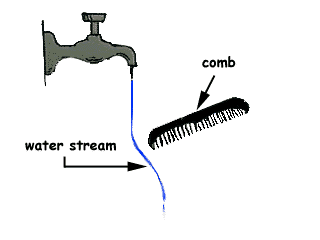|
|
| · | a plastic comb (the larger the better) |
| · | a wool, flannel, or felt cloth (clean dry hair or a pet cat may also work) |
|
|
a small water stream from the faucet |
Procedure:

| 1. | Open the tap and adjust it so that a small stream of water runs out of the faucet. |
| 2. | Rub the comb with a wool, flannel, or felt cloth and hold the back of the comb about 2 cm from the stream (move the comb slowly closer to the stream if it is not attracted to it). |
| Explanation: |
|
The negatively charged comb induces an opposite charge in the water stream and this opposite charge in the water stream gets attracted to the comb. The mass has to be small enought for the electrostatic charge in the comb to move the mass. The static attraction force is relatively small and thus larger masses are not moved. This is why the water stream has to be small so it can be attracted by the charged comb. A larger stream of water needs a much larger static charge to bend. It is suggested not to get the comb wet. The water would take away all the charges and it would be very hard to get the comb recharged with static electricity. Other materials that can be used instead of the comb are: a balloon, hard rubber, or a plastic ruler. You might wish to experiment further by trying other materials found around the house. |
Follow-up:
| 1. | Why did the water stream bend towards the comb? |
| 2. | Was it a magnetic force that attracted the water? |
| 3. | What other materials can we use instead of the comb? |
| 4. | Would a larger stream of water also be bent? EXPLAIN your answer. |
| 5. | What would happen if the charged comb got wet? |
| 6. | Using only those letters in the word STATIC make at least 5 new words. You may rearrange the letters. |
|
Obtaining credit for your efforts
|